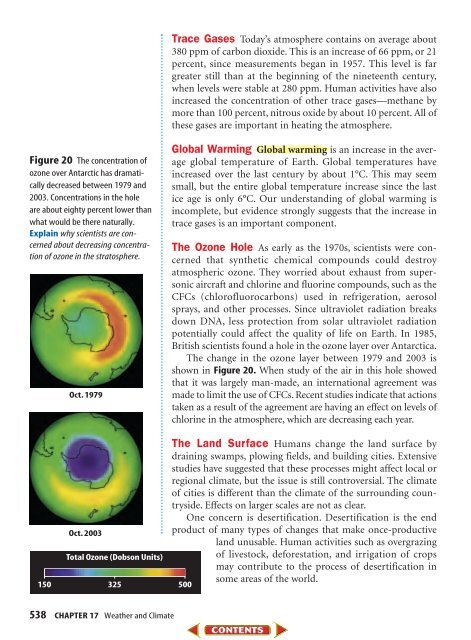CHAPTER 17 Weather and Climate - Mr. Barrow's Science Center
CHAPTER 17 Weather and Climate - Mr. Barrow's Science Center
CHAPTER 17 Weather and Climate - Mr. Barrow's Science Center
Create successful ePaper yourself
Turn your PDF publications into a flip-book with our unique Google optimized e-Paper software.
Trace Gases Today’s atmosphere contains on average about380 ppm of carbon dioxide. This is an increase of 66 ppm, or 21percent, since measurements began in 1957. This level is fargreater still than at the beginning of the nineteenth century,when levels were stable at 280 ppm. Human activities have alsoincreased the concentration of other trace gases—methane bymore than 100 percent, nitrous oxide by about 10 percent. All ofthese gases are important in heating the atmosphere.Figure 20 The concentration ofozone over Antarctic has dramaticallydecreased between 1979 <strong>and</strong>2003. Concentrations in the holeare about eighty percent lower thanwhat would be there naturally.Explain why scientists are concernedabout decreasing concentrationof ozone in the stratosphere.Oct. 1979Oct. 2003Total Ozone (Dobson Units)150 325Global Warming Global warming is an increase in the averageglobal temperature of Earth. Global temperatures haveincreased over the last century by about 1°C. This may seemsmall, but the entire global temperature increase since the lastice age is only 6°C. Our underst<strong>and</strong>ing of global warming isincomplete, but evidence strongly suggests that the increase intrace gases is an important component.The Ozone Hole As early as the 1970s, scientists were concernedthat synthetic chemical compounds could destroyatmospheric ozone. They worried about exhaust from supersonicaircraft <strong>and</strong> chlorine <strong>and</strong> fluorine compounds, such as theCFCs (chlorofluorocarbons) used in refrigeration, aerosolsprays, <strong>and</strong> other processes. Since ultraviolet radiation breaksdown DNA, less protection from solar ultraviolet radiationpotentially could affect the quality of life on Earth. In 1985,British scientists found a hole in the ozone layer over Antarctica.The change in the ozone layer between 1979 <strong>and</strong> 2003 isshown in Figure 20. When study of the air in this hole showedthat it was largely man-made, an international agreement wasmade to limit the use of CFCs. Recent studies indicate that actionstaken as a result of the agreement are having an effect on levels ofchlorine in the atmosphere, which are decreasing each year.The L<strong>and</strong> Surface Humans change the l<strong>and</strong> surface bydraining swamps, plowing fields, <strong>and</strong> building cities. Extensivestudies have suggested that these processes might affect local orregional climate, but the issue is still controversial. The climateof cities is different than the climate of the surrounding countryside.Effects on larger scales are not as clear.One concern is desertification. Desertification is the endproduct of many types of changes that make once-productivel<strong>and</strong> unusable. Human activities such as overgrazingof livestock, deforestation, <strong>and</strong> irrigation of cropsmay contribute to the process of desertification insome areas of the world.500538 <strong>CHAPTER</strong> <strong>17</strong> <strong>Weather</strong> <strong>and</strong> <strong>Climate</strong>


